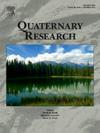Vegetation dynamics in Dhofar, Oman, from the Late Holocene to present inferred from rock hyrax middens
IF 1.8
3区 地球科学
Q3 GEOGRAPHY, PHYSICAL
引用次数: 0
Abstract
Arid regions are especially vulnerable to climate change and land use. More than one-third of Earth's population relies on these ecosystems. Modern observations lack the temporal depth to determine vegetation responses to climate and human activity, but paleoecological and archaeological records can be used to investigate these relationships. Decreasing rainfall across the Late Holocene provides a case study for vegetation response to changing hydroclimate. Rock hyrax (Procavia capensis) middens preserve paleoenvironmental indicators in arid environments where traditional archives are unavailable. Pollen from modern middens collected in Dhofar, Oman, demonstrates the reliability of this archive. Pollen, stable isotope (δ13C, δ15N), and microcharcoal data from fossil middens reveal changes in vegetation, relative moisture, and fire from 4000 cal yr BP to the present. Trees limited to moister areas (e.g., Terminalia) today existed farther inland at ~3100 cal yr BP. After ~2900 cal yr BP, taxa with more xeric affiliations (e.g., Senegalia) had increased. Coprophilous fungal spores (Sporormiella) and grazing indicator pollen revealed an amplified signal of domesticate grazing at ~1000 cal yr BP. This indicates that trees associated with semiarid environments were maintained in the interior desert during ~3000–4000 yr of decreasing rainfall and that impacts of human activity intensified after the transition to a drier environment.从全新世晚期至今,由石岩水螅推断的阿曼佐法尔植被动态
干旱地区特别容易受到气候变化和土地利用的影响。地球上超过三分之一的人口依赖于这些生态系统。现代观测缺乏时间深度来确定植被对气候和人类活动的反应,但古生态和考古记录可以用来研究这些关系。全新世晚期降雨量的减少为植被对水文气候变化的反应提供了一个案例研究。Rock hyrax(Procavia capensis)middens在没有传统档案的干旱环境中保存着古环境指标。在阿曼的多法尔收集的现代middens花粉证明了这个档案的可靠性。来自middens化石的花粉、稳定同位素(δ13C、δ15N)和微宇宙数据揭示了从4000卡年BP到现在植被、相对湿度和火灾的变化。如今,仅限于潮湿地区的树木(如Terminalia)存在于更远的内陆地区,年BP约为3100卡。在大约2900年的BP之后,具有更多xeric附属的分类群(例如塞内加尔)增加了。共生真菌孢子(Spormiella)和放牧指示花粉在约1000卡年的BP下显示出驯化放牧的放大信号。这表明,在3000–4000年的降雨量减少期间,与半干旱环境相关的树木被保留在内陆沙漠中,在向干旱环境过渡后,人类活动的影响加剧。
本文章由计算机程序翻译,如有差异,请以英文原文为准。
求助全文
约1分钟内获得全文
求助全文
来源期刊

Quaternary Research
地学-地球科学综合
CiteScore
4.70
自引率
8.70%
发文量
57
审稿时长
3 months
期刊介绍:
Quaternary Research is an international journal devoted to the advancement of the interdisciplinary understanding of the Quaternary Period. We aim to publish articles of broad interest with relevance to more than one discipline, and that constitute a significant new contribution to Quaternary science. The journal’s scope is global, building on its nearly 50-year history in advancing the understanding of earth and human history through interdisciplinary study of the last 2.6 million years.
 求助内容:
求助内容: 应助结果提醒方式:
应助结果提醒方式:


